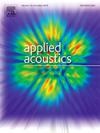Low-frequency broadband acoustic absorption characteristics of honeycomb-type gradient perforated porous acoustic metamaterials paired with embedded necks
IF 3.4
2区 物理与天体物理
Q1 ACOUSTICS
引用次数: 0
Abstract
Conventional acoustic structures struggle to achieve a balance between low-frequency and broadband absorption while preserving structural compactness at frequencies below 500 Hz. In this paper, a novel honeycomb-type gradient perforated porous acoustic metamaterial paired with an embedded neck is proposed. An analytical model of the sound absorption coefficient of metamaterials is developed based on the homogenized equivalent method, with a comparison between finite elements and experimental results. The results indicate that a new energy compensation mechanism is discovered in this structure: the porous material with gradual perforation replaces the neck as the main dissipation source, which greatly increases the tunable acoustic absorption of the metamaterial. In addition, the proposed metamaterial achieves excellent acoustic absorption at low frequency 265 Hz with a relative absorption bandwidth of 58.5 % while maintaining a compact structure thickness of just 52 mm. Compared with the perforated plate structure, the embedded neck design reduces the thickness of the metamaterial structure by 21.2 %. The acoustic absorption coefficient α > 0.9 within the frequency range of 268 Hz to 473 Hz was achieved through the connection of seven cells in parallel. The acoustic metamaterials presented in this paper provide an innovative solution for low-frequency noise control on the sub-wavelength scale.

求助全文
约1分钟内获得全文
求助全文
来源期刊

Applied Acoustics
物理-声学
CiteScore
7.40
自引率
11.80%
发文量
618
审稿时长
7.5 months
期刊介绍:
Since its launch in 1968, Applied Acoustics has been publishing high quality research papers providing state-of-the-art coverage of research findings for engineers and scientists involved in applications of acoustics in the widest sense.
Applied Acoustics looks not only at recent developments in the understanding of acoustics but also at ways of exploiting that understanding. The Journal aims to encourage the exchange of practical experience through publication and in so doing creates a fund of technological information that can be used for solving related problems. The presentation of information in graphical or tabular form is especially encouraged. If a report of a mathematical development is a necessary part of a paper it is important to ensure that it is there only as an integral part of a practical solution to a problem and is supported by data. Applied Acoustics encourages the exchange of practical experience in the following ways: • Complete Papers • Short Technical Notes • Review Articles; and thereby provides a wealth of technological information that can be used to solve related problems.
Manuscripts that address all fields of applications of acoustics ranging from medicine and NDT to the environment and buildings are welcome.
 求助内容:
求助内容: 应助结果提醒方式:
应助结果提醒方式:


